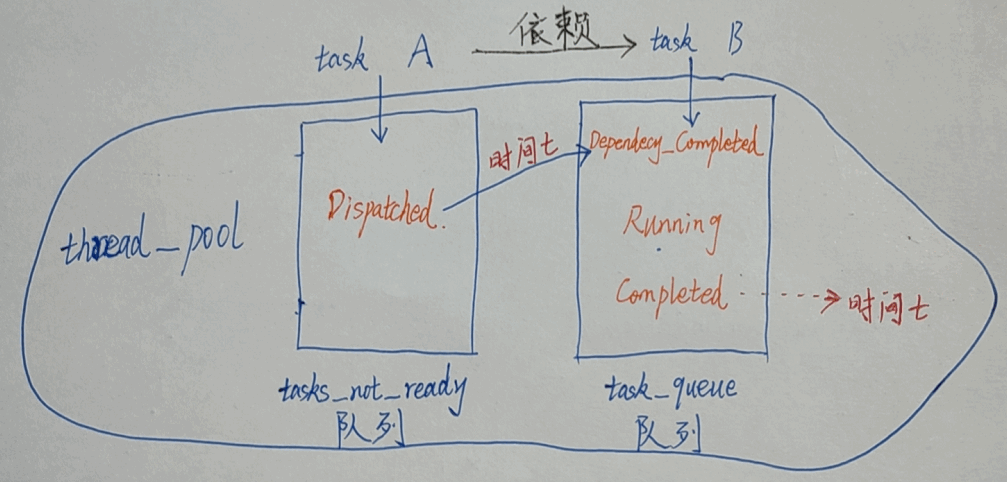1
2
3
4
5
6
7
8
9
10
11
12
13
14
15
16
17
18
19
20
21
22
23
24
25
26
27
28
29
30
31
32
33
|
class Task
{
public:
friend class ThreadPoolInterface;
State GetState() LOCKS_EXCLUDED(mutex_);
void SetWorkItem(const WorkItem& work_item);
void AddDependency(std::weak_ptr<Task> dependency) LOCKS_EXCLUDED(mutex_);
private:
void Execute() LOCKS_EXCLUDED(mutex_);
void SetThreadPool(ThreadPoolInterface* thread_pool) LOCKS_EXCLUDED(mutex_);
void OnDependenyCompleted();
using WorkItem = std::function<void()>;
enum State { NEW, DISPATCHED, DEPENDENCIES_COMPLETED, RUNNING, COMPLETED };
WorkItem work_item_ ;
ThreadPoolInterface* thread_pool_to_notify_ = nullptr;
State state_ GUARDED_BY(mutex_) = NEW;
std::set<Task*> dependent_tasks_ GUARDED_BY(mutex_);
};
|
Task类不是线程,可以理解为有状态和依赖的函数,核心的成员变量work_item_是仿函数,其返回类型void。
1
2
3
4
5
6
7
8
9
10
11
12
13
14
15
16
17
18
19
20
21
22
23
|
class ThreadPool : public ThreadPoolInterface
{
public:
explicit ThreadPool(int num_threads);
std::weak_ptr<Task> Schedule(std::unique_ptr<Task> task);
private:
void DoWork();
void NotifyDependenciesCompleted(Task* task);
bool running_ = true;
std::vector<std::thread> pool_ ;
std::deque<std::shared_ptr<Task>> task_queue_ ;
absl::flat_hash_map<Task*, std::shared_ptr<Task>> tasks_not_ready_;
};
|
看构造函数
1
2
3
4
5
6
7
8
9
10
| ThreadPool::ThreadPool(int num_threads)
{
absl::MutexLock locker(&mutex_);
for (int i = 0; i != num_threads; ++i)
{
pool_.emplace_back([this]() { ThreadPool::DoWork(); });
}
}
|
大致看ThreadPool::DoWork(),最后执行了ThreadPoolInterface::Execute,其实就是Task::Execute。 每个线程与DoWork()函数绑定,也就是线程在后台不断执行DoWork()函数
新的Task如果有依赖项,通过Thread_pool::Schedule添加到 Thread_pool的 tasks_not_ready_队列中。队列中的Task状态是变化的,等依赖项执行完成,Task状态变为DEPENDENCIES_COMPLETED,然后再插入task_queue_队列。最终所有Task都会插入task_queue_中,在DoWork中得到执行。
如果该Task没有依赖,直接插入task_queue_,准备执行。
对任一个任务的状态转换顺序为:NEW—->DISPATCHED—->DEPENDENCIES_COMPLETED—->RUNNING—->COMPLETED
Thread_pool通过固定数量的thread与task_queue_(待执行的task队列)执行函数绑定。Thread_pool 按照队列首尾顺序不断执行Task。


